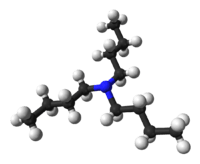Tributylamine
| Tributylamine | |
|---|---|
 | |
 | |
| IUPAC name N,N-Dibutyl-1-butanamine | |
| Other names Tri-n-butylamine | |
| Identifiers | |
| CAS number | 102-82-9 |
| PubChem | 7622 |
| ChemSpider | 7340 |
| Jmol-3D images | Image 1 |
| |
| |
| Properties | |
| Molecular formula | C12H27N |
| Molar mass | 185.35 g mol−1 |
| Appearance | Colorless to yellow liquid |
| Density | 0.78 g/cm3[1] |
| Melting point | −70 °C; −94 °F; 203 K ([1]) |
| Boiling point | 214 °C; 417 °F; 487 K ([1]) |
| Solubility in water | 50 mg/L (20 °C)[1] |
| Hazards | |
| Flash point | 86 °C (187 °F)[1] |
| Except where noted otherwise, data are given for materials in their standard state (at 25 °C (77 °F), 100 kPa) | |
| Infobox references | |
Tributylamine (TBA) is an organic compound with the molecular formula C12H27N. It is a colorless to yellow, hygroscopic liquid with an amine-like odor which is very poorly soluble in water.
Uses
Tributylamine has a wide range of applications. It is an intermediate in the manufacture of other chemical compounds, including quaternary ammonium compounds (such as tributylmethylammonium chloride and tributylbenzylammonium chloride), pharmaceuticals, agrochemicals, surfactants, lubricant additives, vulcanization accelerators and dyes.[2] It is also used as a solvent and as a catalyst (proton acceptor) in organic syntheses and polymerization (including polyurethanes).